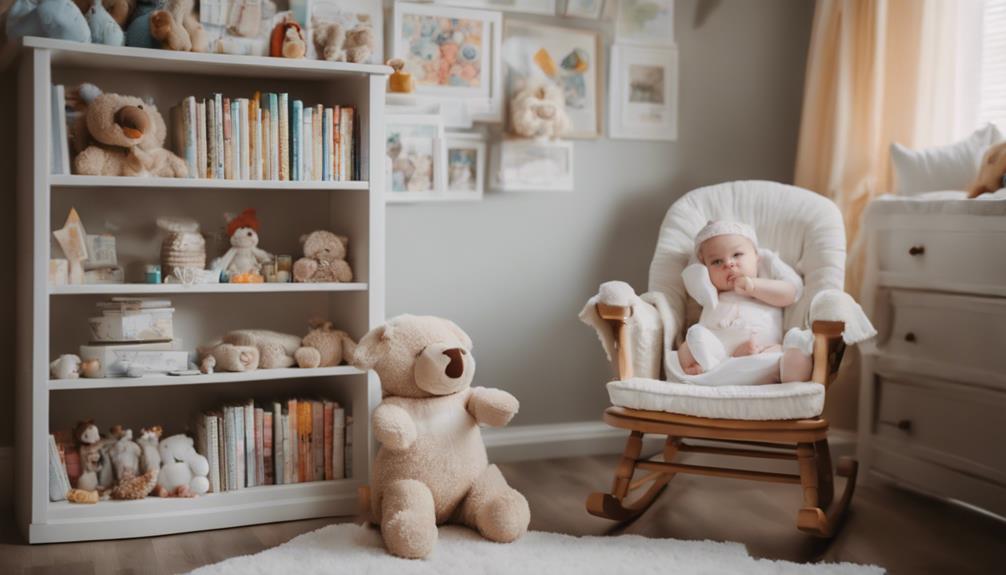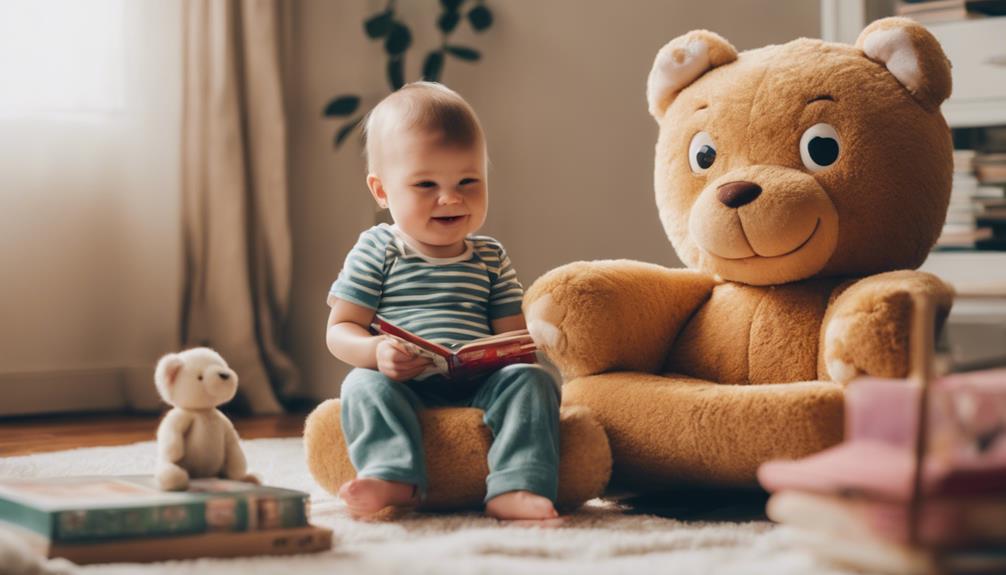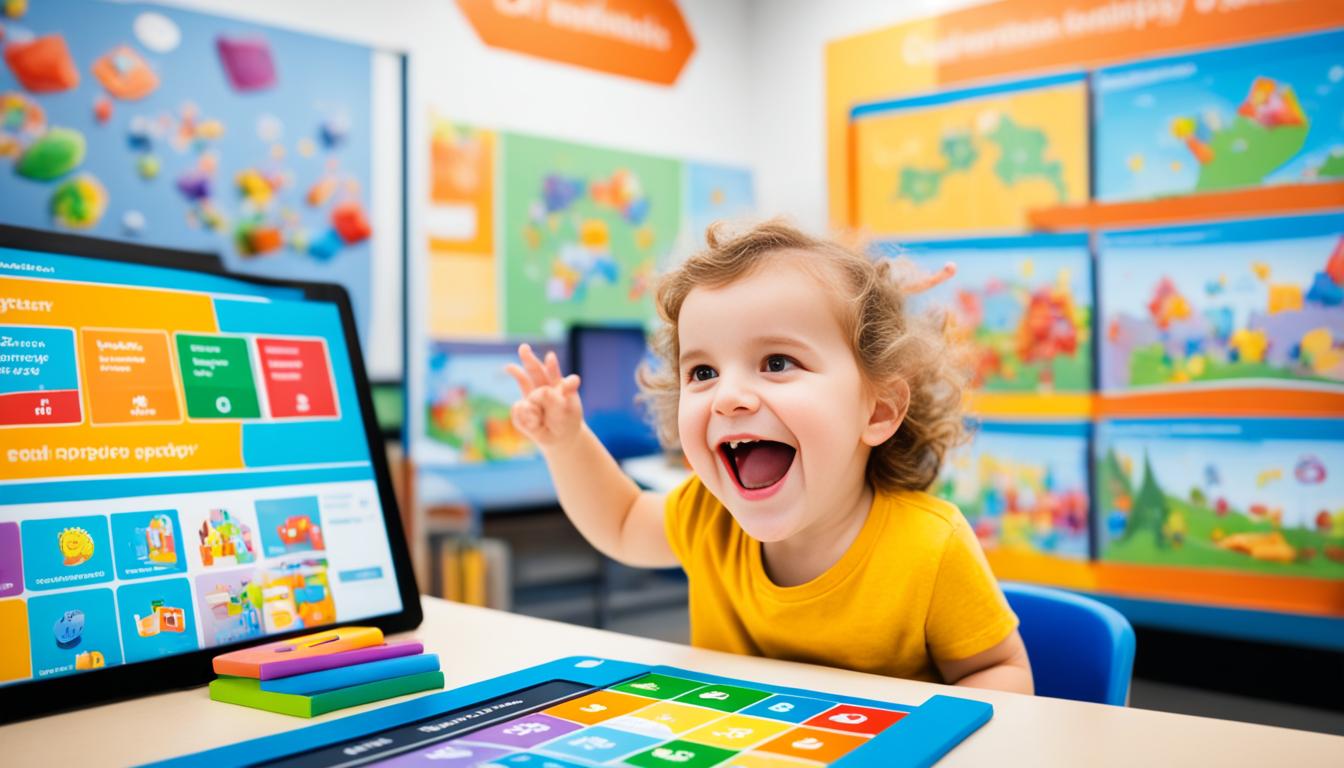Reading a book to your baby has many advantages. It boosts brain activity, encourages language development, and expands vocabulary. This supports academic success and promotes strong brain connections. Reading also improves communication skills, advancing cognitive growth and effective verbal expression. Additionally, it enhances emotional bonds, promoting empathy and trust. By exposing your baby to various words and tones, you help in their cognitive development and memory skills. It also establishes a basis for social communication skills and literacy, sparking imagination and enhancing cognitive abilities. Each page turn reveals a world of benefits waiting to be discovered.
Key Takeaways
- Enhances brain activity and cognitive development.
- Stimulates language skills and vocabulary expansion.
- Builds a strong emotional connection and trust.
- Improves listening, memory, and social communication skills.
- Establishes a solid literacy skills foundation for the child.
Cognitive Development Benefits
Enhancing your baby's cognitive development through reading aloud offers numerous benefits for their language skills and brain activity. Reading to your baby not only introduces them to the world of books but also aids in stimulating their brain, specifically in areas related to language and communication.
When you read to your baby, you're exposing them to a wide variety of words, helping to develop a rich vocabulary right from the start. These early interactions with books and language lay a solid foundation for their cognitive development, fostering logical thinking and writing skills as they grow.
Furthermore, incorporating daily reading sessions into your routine can contribute to forming strong synapses between neurons in your baby's brain. This process aids in promoting healthy brain development, setting the stage for academic success in the future.
Language Skills Enhancement
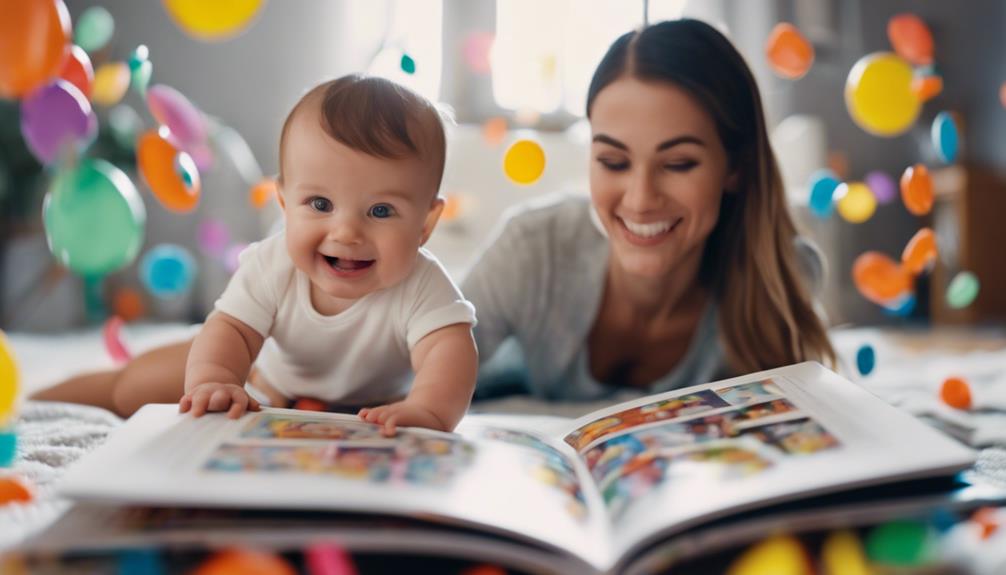
Reading to your baby helps expand their vocabulary, improve their communication skills, and stimulate cognitive growth.
Through regular reading sessions, you expose your child to a wide variety of words not commonly used in everyday conversations, promoting precision in language.
Early exposure to written language sets the stage for effective verbal communication skills and helps them convey complex ideas with ease.
Vocabulary Development
By exposing your baby to a diverse range of words and language patterns through reading, you can greatly enhance their vocabulary development. Language development in infants and toddlers is vital for their communication skills.
Regular exposure to books introduces them to a wide variety of words, aiding in vocabulary development. As babies grow, they acquire new words at different stages, gradually expanding their vocabulary.
Reading to your baby not only helps them learn words by age but also equips them with the skills they need for effective communication. Through exposure to books, infants and toddlers encounter words that mightn't be commonly used in everyday conversations, enriching their language capabilities.
This early exposure to written language lays a strong foundation for precise communication skills and understanding complex ideas. By fostering vocabulary development through reading, you're setting the stage for your baby's future language acquisition and overall communication proficiency.
Communication Skills Boost
To enhance your baby's communication skills and boost their language abilities, reading aloud exposes them to a variety of words, tones, and speech patterns. When you read to your baby, you aren't only introducing new vocabulary but also helping in language development and fostering early literacy skills.
Regular reading sessions play a significant role in improving listening and memory skills in infants. By incorporating numbers, letters, colors, and shapes through books, you can also aid in cognitive development.
Reading aloud to babies stimulates brain activity related to language and communication, laying a strong foundation for their future learning. The exposure to different speech patterns and tones during reading sessions helps your baby in recognizing and understanding various forms of communication, which is essential for their overall language development.
Cognitive Growth Stimulation
Enhancing your baby's cognitive growth involves stimulating their language skills for optimal development. When it comes to reading to your baby, this practice not only introduces them to the world of books but also plays a significant role in boosting their cognitive abilities. Here's how reading to your baby enhances their cognitive growth:
- Language Skills Enhancement:
Reading aloud exposes your baby to new words, sentence structures, and concepts, aiding in the development of their language skills.
- Brain Development:
Engaging with books supports the growth of neural connections in your baby's brain, facilitating overall cognitive development.
- Boosts Literacy:
Research shows that reading to babies from an early age sets a strong foundation for literacy, helping them develop vocabulary, comprehension, and communication skills.
Emotional Connection Strengthening

Reading a book to your baby helps you bond through storytelling, creating shared moments of empathy and understanding.
It enhances your relationship by fostering emotional connections and trust.
These interactions lay a solid foundation for building a strong and loving parent-child bond.
Bonding Through Storytelling
Strengthen your emotional connection with your baby through the power of storytelling. Engaging in regular storytelling sessions with your little one can have a profound impact on your parent-child relationship.
Here's how bonding through storytelling can enhance your emotional connection:
- Shared Reading Experiences: Reading together creates a special bond as you both explore new worlds and characters, fostering a sense of togetherness.
- Trust and Continuity: Regular storytelling sessions build trust and a sense of continuity in your relationship, providing stability and comfort for your baby.
- Intimacy and Security: One-on-one reading time fosters intimacy and security, nurturing a safe space for your baby to explore emotions and thoughts.
Developing Empathy Skills
As you engage in storytelling with your baby, you lay the foundation for developing their empathy skills through exposure to various emotions and social scenarios depicted in books.
By reading to your baby, you help them understand and identify emotions as they witness characters in stories navigate different feelings. This exposure allows babies to start recognizing and mirroring emotional responses in their own lives.
Books with diverse characters and emotions can play a vital role in helping babies develop a deeper understanding of the world around them.
The emotional connection formed during these reading sessions not only enhances the bond between you and your baby but also fosters trust.
Through these shared experiences, your baby learns to empathize with others and navigate the complexities of emotions and social situations, setting the stage for meaningful connections with those around them.
Enhancing Parent-Child Relationship
Developing a deep emotional bond with your baby through shared reading experiences is essential for enhancing the parent-child relationship. Reading to your baby promotes emotional bonding, creating a sense of security and comfort as they associate the sound of your voice with positive interactions.
This shared experience of reading together provides one-on-one time, fostering trust and intimacy between you and your child. Regular reading sessions help establish a routine that strengthens the parent-child relationship, offering opportunities for ongoing conversations and connections.
The emotional connection formed through these reading activities can have long-lasting positive effects on your baby's development and well-being.
- Reading to your baby promotes emotional bonding through shared experiences and one-on-one time.
- It creates a sense of security and comfort as your baby associates the sound of your voice with positive interactions.
- Regular reading sessions help establish a routine that fosters trust and intimacy between parent and child.
Speech Development Promotion

Reading a book to your baby enhances their speech development by exposing them to a wide range of words and sounds. When you read aloud to your little one, you're helping them in building a strong vocabulary necessary for effective communication skills.
Through regular reading sessions, infants and toddlers absorb language patterns that aid in their language development. Exposure to written language during reading not only enhances their vocabulary but also helps in refining their speech precision.
The act of reading aloud stimulates brain activity related to language and communication, fostering their verbal communication skills. By engaging in reading activities with your baby, you're assisting them in grasping pronunciation nuances and grammatical structures that are essential for clear and effective verbal expression.
Vocabulary Expansion
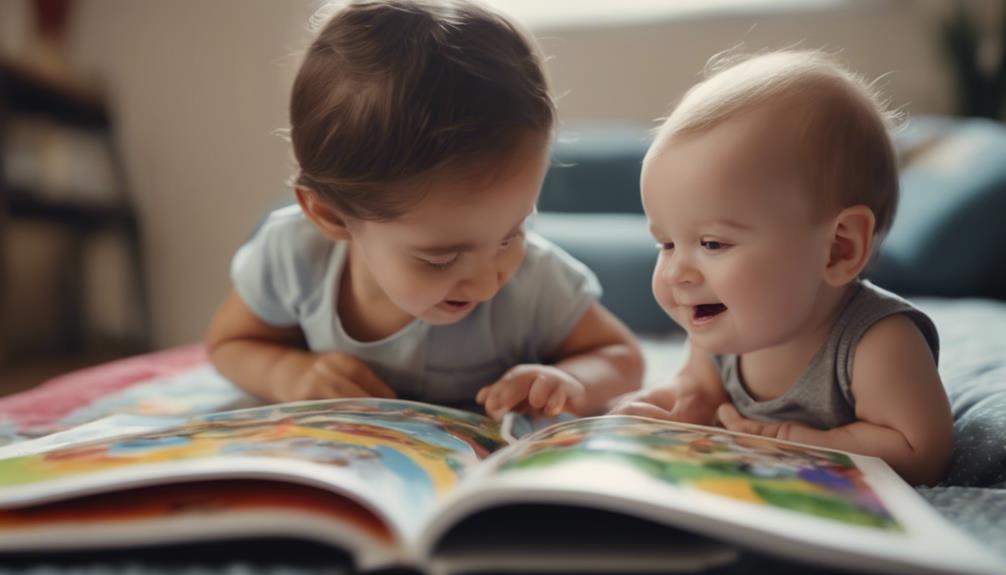
Expanding your baby's vocabulary through reading introduces them to new words and language patterns from an early age. As your baby starts to explore books with you, they begin their journey of vocabulary expansion. Here's how this process benefits them:
- Exposure to a variety of words: Reading aloud exposes your baby to a wide range of vocabulary that they may not encounter in everyday conversations.
- Learning to express themselves effectively: By introducing different words and language patterns, babies can learn how to communicate their thoughts and feelings more clearly.
- Building a strong foundation for language acquisition: The more words your baby hears, the better equipped they become to understand and use language effectively as they grow. This lays the groundwork for when they start to learn to read and know more words, aiding in their overall language development.
Listening and Memory Improvement

Enhancing your baby's listening and memory skills through regular reading sessions provides a strong foundation for cognitive development. Reading aloud to your baby not only helps with their listening skills by focusing on speech sounds and rhythms but also aids in memory formation. As you engage in reading sessions repeatedly, your baby starts recognizing familiar words and story patterns, which in turn enhances their memory skills. This active participation stimulates brain activity associated with memory retention, creating a robust basis for improved memory recall in the future. By engaging your baby with books early on, you are effectively enhancing their ability to retain and recall information as they grow.
| Benefits of Reading to Your Baby |
|---|
| – Improved listening skills |
| – Enhanced memory skills |
| – Stimulated brain activity |
Social Communication Skills Building
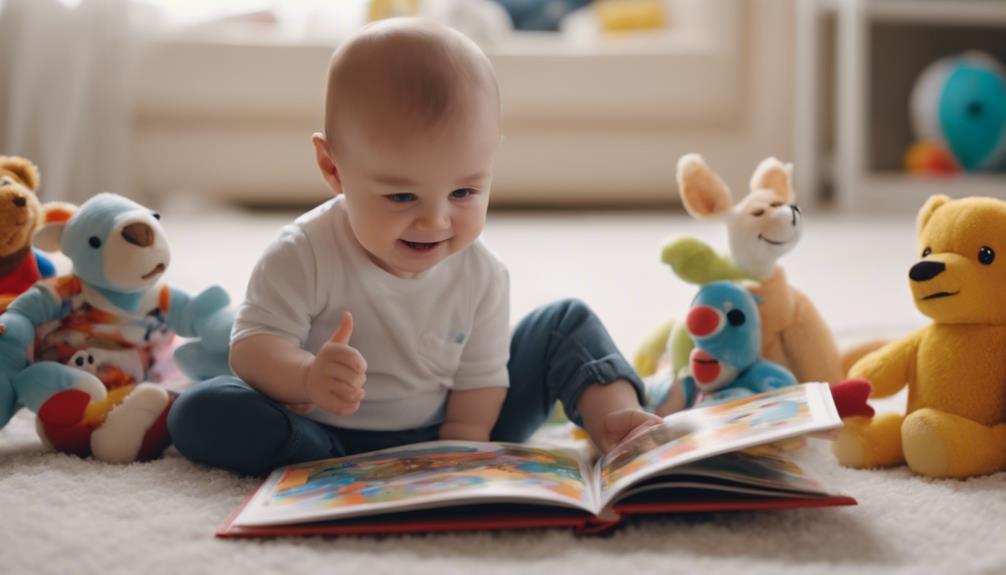
To further nurture your baby's development, exploring their social communication skills is key. Reading aloud plays an important role in enhancing these skills and fostering important connections.
Here are three ways reading to your baby can help build their social communication skills:
- Bonding: Reading sessions create a special bond between you and your baby, as you share moments of closeness and connection through storytelling.
- Emotional Connections: By engaging with books, babies learn to recognize and understand emotions, which are essential for effective social interactions.
- Non-Verbal Cues: Through exposure to various stories and characters, babies begin to pick up on non-verbal cues like facial expressions and gestures, aiding in their communication development.
Literacy Skills Foundation
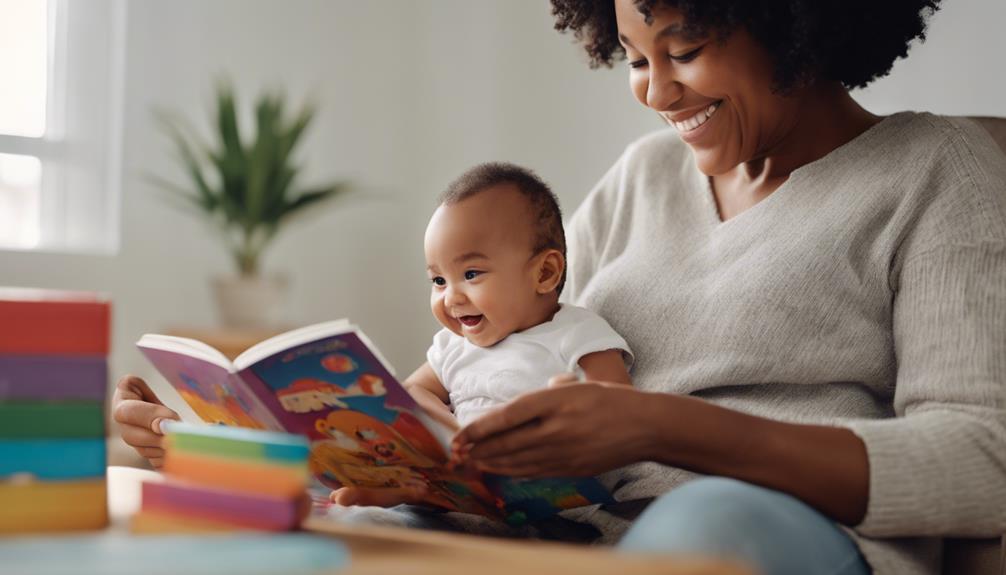
Building a strong foundation in literacy skills for your baby begins with regular reading sessions that expose them to language patterns, vocabulary, and storytelling from an early age. By engaging with books, your baby not only learns new words but also starts recognizing language patterns, which are essential for communication.
Through storytelling, your baby's imagination is ignited, and they begin to understand the structure of narratives. These early experiences lay the groundwork for developing essential literacy skills.
Regular reading sessions help your baby not only learn new words but also enhance their listening skills and memory retention. Additionally, exposure to concepts like letters, numbers, colors, and shapes from books aids in their cognitive development.
Frequently Asked Questions
Why Is Reading Books Important for Babies?
Reading books to your baby is essential as it enhances language skills, boosts imagination, and creates emotional connections. It introduces uncommon words, aids in social development, and sets the stage for literacy success.
When Should I Start Reading Books to My Baby?
Start reading to your baby right away! A great way to introduce language early on and build a connection with your little one. Reading daily sets a wonderful habit, benefiting their language skills and bonding with you.
How Many Books Should I Read to My Baby a Day?
You should aim to read at least one book a day to your baby. This simple routine can have a significant impact on their language development and cognitive skills, setting a strong foundation for their literacy journey.
Does It Matter What You Read to Your Baby?
Hey there, when you read to your baby, what you choose to read definitely matters! Opt for engaging books with diverse content. These choices can influence language development and cognitive skills positively.
Conclusion
So, next time you're snuggled up with your little one, pick up a book and immerse yourselves in a world of wonder together.
Reading to your baby not only enhances their cognitive development and language skills but also strengthens your emotional connection like never before.
Remember, a book in hand is a friend indeed!


